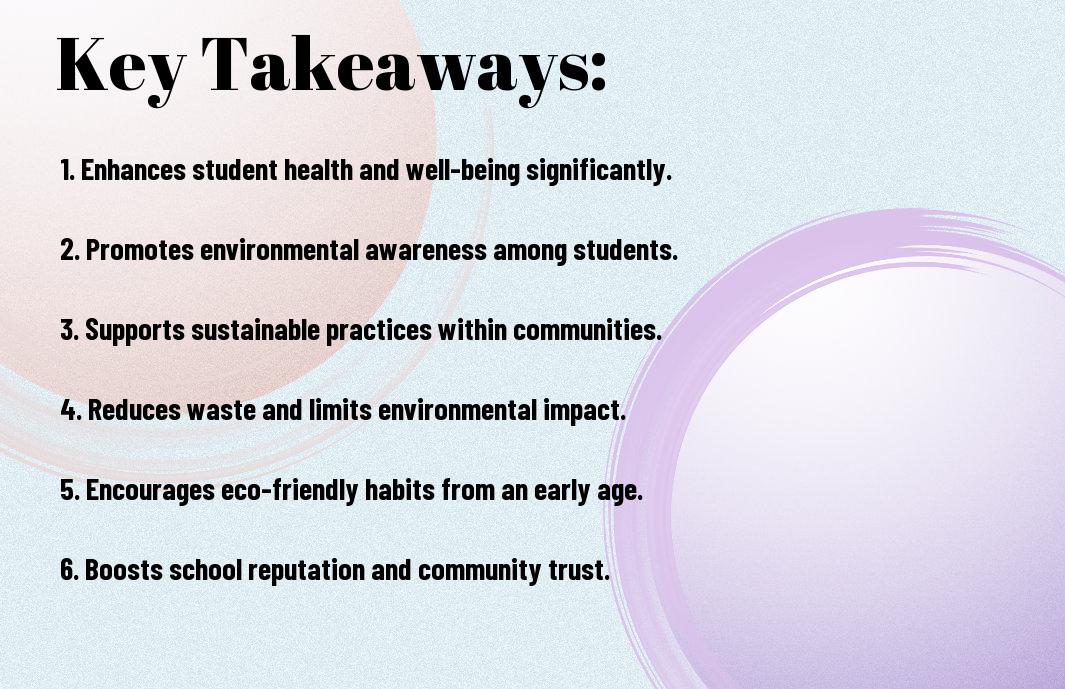As you consider the environmental impact of your school, you may wonder how to reduce your ecological footprint. You can start by incorporating green supplies into your daily operations. By making this simple switch, you will not only be contributing to a healthier planet, but also teaching your students valuable lessons about sustainability. Your school can benefit from the numerous advantages of green supplies, and you can take the first step towards creating a more environmentally-friendly learning environment.

Key Takeaways:
To promote a healthier and more sustainable learning environment, it’s necessary to consider the impact of school supplies on the planet. Here are the main points to consider:
- Every school can benefit from using eco-friendly supplies, such as pencils made from recycled materials, to reduce waste and minimize their carbon footprint.
- Implementing green practices, like using reusable bags and biodegradable products, can help schools save money in the long run and set a positive example for students.
- By choosing environmentally responsible supplies, schools can contribute to a healthier environment, reduce exposure to toxic chemicals, and promote a culture of sustainability among students and staff.

Benefits of Green Supplies
Your school can greatly benefit from switching to green supplies, as they offer a cleaner and healthier environment for students and staff, while also promoting sustainability.
Environmental Impact
Benefits to the environment are numerous, as green supplies reduce waste, conserve natural resources, and minimize your school’s carbon footprint, allowing you to contribute to a more sustainable future.
Health Benefits
Above all, green supplies can greatly improve the health and wellbeing of your students and staff, as they reduce exposure to toxic chemicals and pollutants, creating a safer learning environment for you.
This improvement in health can have a significant impact on your students’ ability to focus and learn, as a healthier environment can lead to better attendance, improved concentration, and enhanced overall performance, allowing you to see tangible results from making the switch to green supplies.
Cost-Effective Options
You can reduce your environmental impact without breaking the bank by choosing green supplies for your school. Many eco-friendly options are available at competitive prices, making them a viable choice for budget-conscious institutions.
Affordable Alternatives
Around this time, you may be considering switching to eco-friendly alternatives, such as recycled paper and refillable pens, which can be just as effective as traditional supplies at a lower cost.
Long-Term Savings
Options like energy-efficient lighting and solar panels may require an initial investment, but they can lead to significant long-term savings on your school’s utility bills, allowing you to allocate your resources more efficiently.
It is imperative to consider the long-term benefits of green supplies, as they can lead to significant cost savings over time, allowing you to invest in other areas of your school, such as education and extracurricular activities, ultimately benefiting your students and community.
Innovative Solutions
After adopting green supplies, you will notice a significant reduction in your school’s environmental footprint. You can explore various options, such as reusable bags, refillable water bottles, and energy-efficient equipment, to create a sustainable learning environment.
Eco-Friendly Products
Upon considering your school’s supply needs, you can opt for eco-friendly products made from recycled materials, biodegradable plastics, or sustainable wood, which reduce waste and promote a healthier environment.
Sustainable Practices
Toward achieving a greener school, you can implement sustainable practices, such as recycling programs, composting, and energy conservation, to minimize your school’s impact on the environment and promote a culture of sustainability among students and staff.
Products that support sustainable practices, such as solar-powered chargers and energy-efficient lighting, can help you reduce your school’s carbon footprint and create a healthier learning environment, allowing you to make informed decisions about your school’s supplies and practices.
Implementation Strategies
Keep in mind that introducing green supplies to your school requires a well-planned approach. You can start by conducting an audit of your current supplies and identifying areas where eco-friendly alternatives can be implemented.
Teacher Involvement
Across the board, teacher support is crucial for a successful transition to green supplies. You will need to educate your teachers on the benefits and proper use of eco-friendly supplies to ensure a smooth integration into your school’s daily operations.
Student Participation
Involving students in the process of adopting green supplies is key to creating a sustainable school culture. You can encourage your students to participate in recycling programs, suggest eco-friendly supply options, and take ownership of reducing waste in your school.
In fact, by empowering your students to take an active role in promoting sustainability, you can foster a sense of responsibility and environmental awareness that extends beyond the classroom, ultimately benefiting your entire community.
Green Supply Examples
For a school to reduce its environmental footprint, you can consider using eco-friendly supplies. Examples of green supplies include recycled materials, biodegradable products, and sustainable equipment.
Recycled Materials
Oddly, you may not be aware that many schools are now using recycled materials for various purposes, such as notebooks made from recycled paper and pens made from recycled plastic.
Biodegradable Products
Obviously, one of the easiest ways to reduce waste is to use biodegradable products, such as compostable bags and bioplastics, which can easily decompose and do not harm the environment.
Consequently, when you choose biodegradable products, you are not only reducing your school’s waste but also teaching your students about the importance of sustainability and environmental conservation, which can have a lasting impact on their behavior and attitude towards the environment.
Challenges and Opportunities
Despite the benefits of green supplies, you may face obstacles when implementing them in your school. You will need to weigh the costs and benefits, considering your school’s budget and resources.
Overcoming Barriers
Beyond the initial investment, you can find ways to make green supplies a sustainable choice for your school. You will need to assess your school’s specific needs and find solutions that work for you.
Collaborative Efforts
About the importance of teamwork, you should consider involving your community in the process of adopting green supplies. You can work with teachers, students, and parents to make eco-friendly choices.
Overcoming the challenges of implementing green supplies requires a collective effort. You can start by conducting a thorough assessment of your school’s current practices and identifying areas where you can make a positive impact. By working together, you can develop a plan to incorporate green supplies into your school’s daily operations, reducing waste and promoting sustainability. As you make progress, you can share your successes and learn from others, ultimately creating a more environmentally friendly learning environment for your students.
Final Words
Now, as you consider the benefits of eco-friendly products, you can see that your school’s transition to green supplies is a step in the right direction. You will not only reduce your environmental footprint, but also promote a healthier learning environment for your students. By making this switch, you are investing in your community’s well-being and setting a positive example for your students to follow. Your decision will have a lasting impact on the future of your school and the planet.
FAQ
Q: What are green supplies and why are they important for schools?
A: Green supplies refer to products and materials that are eco-friendly, non-toxic, and sustainable. They are important for schools because they help reduce the institution’s environmental footprint, promote a healthy learning environment, and teach students the value of sustainability and conservation. By incorporating green supplies into daily operations, schools can significantly minimize their impact on the environment and create a better future for generations to come.
Q: How can green supplies contribute to a healthier learning environment?
A: Traditional school supplies often contain harmful chemicals and toxins that can negatively impact the health and well-being of students and staff. Green supplies, on the other hand, are made from natural materials and are free from toxic substances, reducing the risk of respiratory problems, allergies, and other health issues. By using green supplies, schools can create a healthier and safer environment that promotes the overall well-being of their students and staff.
Q: What types of green supplies can schools use to reduce their environmental impact?
A: There are numerous types of green supplies that schools can use to reduce their environmental impact. These include recycled paper products, such as notebooks and pencils made from recycled materials, refillable water bottles, energy-efficient lighting and equipment, non-toxic cleaning products, and reusable bags and containers. Additionally, schools can also consider using digital tools and resources to reduce paper waste and minimize their carbon footprint.
Q: Can green supplies help schools save money in the long run?
A: Yes, green supplies can help schools save money in the long run. Although some green supplies may be more expensive than their traditional counterparts, they are often more durable and long-lasting, reducing the need for frequent replacements. Additionally, green supplies can help schools reduce their energy consumption and waste management costs, leading to significant savings over time. By investing in green supplies, schools can reduce their operational costs and allocate more resources to support student learning and academic programs.
Q: How can schools encourage students and staff to adopt green habits and practices?
A: Schools can encourage students and staff to adopt green habits and practices by incorporating environmental education into their curriculum, launching recycling programs and awareness campaigns, and providing incentives for sustainable behaviors. Schools can also involve students in the decision-making process of selecting green supplies and implementing sustainable practices, empowering them to take ownership of their environmental impact. By fostering a culture of sustainability, schools can inspire students and staff to make eco-friendly choices and develop lifelong habits that benefit the environment and their communities.

